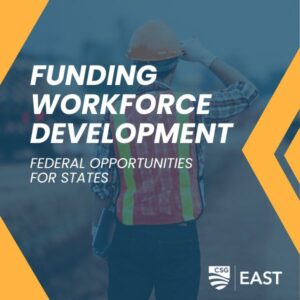Federal funding for workforce development: Federal opportunities for states
 Continued labor shortages are putting pressure on state leaders. Since the pandemic, states have experienced a decrease in the labor force, resulting in more job openings than workers seeking employment. While America’s rising retirement-age population is a contributing factor, many jobs remain unfilled due to a lack of trained, qualified candidates.
Continued labor shortages are putting pressure on state leaders. Since the pandemic, states have experienced a decrease in the labor force, resulting in more job openings than workers seeking employment. While America’s rising retirement-age population is a contributing factor, many jobs remain unfilled due to a lack of trained, qualified candidates.
To untie this particular knot in the labor market, many states are focusing efforts to address labor shortages on reskilling and upskilling workers or potential workers. As a result, states throughout the country are seeking to establish and expand workforce pipelines, such as registered apprenticeships, to fill key shortage areas. As state leaders develop these initiatives, many are asking what opportunities are available to fund workforce development.
To help answer this question, CSG East’s Education and Workforce Development Committee hosted a webinar featuring Emlyn Bottomley from the U.S. Department of Labor (DOL), and Paige Shevlin from the U.S. Department of Transportation (DOT). The speakers addressed resources available to states through their respective agencies and through federal legislation, such as the Bipartisan Infrastructure Law (BIL).
DOL invests in workforce development in formula and Workforce Innovation and Opportunity Act funds (WIOA), along with discretionary grant programs. One resource available to states to support the creation of high-quality jobs is the Good Jobs Initiative. The initiative, announced in January 2022, works with state and local governments to ensure that federal investments create high-quality jobs and equitable pathways into those jobs. As of January 2023, the initiative, working in collaboration with other federal agencies – including the Departments of Transportation, Commerce, and Energy — had incentivized equity and good jobs in over $97 billion dollars of grant funding, according to the initiative’s website. Along with the U.S. Department of Commerce, the Good Jobs Initiative developed a Good Jobs Principles Fact Sheet identifying the elements of a quality job. To assist state, tribal, and territorial governments in leveraging federal infrastructure funds to support high-quality jobs, DOL created the Good Jobs Toolkit.
The DOT provides few direct funding opportunities specific to workforce development. However, most DOT funding is in the form of competitive grants, which can be used for workforce development relating to a transportation project. Funding can be used for short-term training programs and job coordinators to ensure project workforce needs are met. DOT has approximately $124.4 billion available in competitive funding for states, cities, transit agencies, and ports. Through DOT’s agreement with DOL’s Good Jobs Initiative, most funding programs include selection criteria or priority consideration for job quality and workforce development.
States play a key role receiving funds, along with determining how the funds are spent. During the webinar, Emlyn Bottomley, a policy analyst at the DOL Good Jobs Initiative, noted that some federal infrastructure programs provide flexibility to directly fund workforce development. In addition, states can leverage these funds to incentivize subgrantees to invest in equitable workforce development. Most funds through the federal BIL are formula or block funds distributed to states, localities, tribes, or territories. State leaders have discretion over how this money is distributed, enabling them to incentivize or require that funds be invested in workforce development, such as apprenticeships and other equitable pathways for underserved communities.
Most DOT funding available through BIL are formula funds ($466 billion) — predominately state highway formula funds. Under new rules through BIL, all highway formula funds can be used for workforce development, giving states a substantial opportunity to budget their workforce development needs in these transportation projects. BIL specifically added eligibility for support to community colleges and vocational schools in addition to four-year universities as well as apprenticeships, pre-apprenticeships, and on-the-job training. States can also utilize up to 0.5 percent of Federal Transit Administration Urban Area Formula Program funds for workforce development.
Amid continuing labor shortages, the federal government is providing new opportunities to support workforce development in the states. Through cross-agency collaboration, workforce development – in particular, ensuring quality, high-paying jobs — is a priority in many funding opportunities. For more information on these opportunities, view the webinar recording and slides on the CSG East website.






